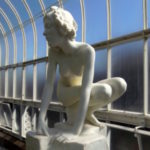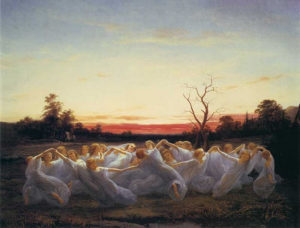Alfheim of the Elves and Our Shifting Sense of Self


Meadow Elves by Nils Blommér (1850)
A Colony of the Gods?
In Norse myth, Alfheim is one of the nine realms and, more specifically, the home of the elves. When you first hear about it, it sounds like a great vacation spot but, in truth, it’s a rather sketchy and poorly documented place. It comes up ever-so-briefly in “The Ballad of Grimnir”:
And Alfheim the gods
to Freyr once gave
as a tooth-gift in ancient times.
That attestation is often glossed over in the literature, but it is one nutty group of words. It states, in essence, that “the gods” gave Freyr (another god) the realm of the elves as a teething present! You see, a “tooth-gift” refers to the custom of making a present to a baby when it gets its first tooth.
So, let’s get this straight. The gods gave an entire realm packed with beautiful, noble creatures to a baby? Now, that sounds like some very serious colonialism.
Or Maybe the Aesir and/or Vanir Are Elves?
Another theory is that this Freyr actually was an elf. Snorri Sturluson, the author of the Prose Edda (aka, Younger Edda) reported that Freyr was one of the Vanir, which was one of the two flavors of Norse gods. But the term Vanir seems to have been rare in Eddaic and Skaldic verse, so some suspect that álfar and Vanir are different words for the same group of beings.
Just to add another level of complexity, there’s also evidence that the elves and the Aesir (that other flavor of Norse god) were the same. Wikipedia reports”
[E]lves are frequently mentioned in the alliterating phrase Æsir ok Álfar (‘Æsir and elves’) and its variants. This was clearly a well established poetic formula, indicating a strong tradition of associating elves with the group of gods known as the Æsir, or even suggesting that the elves and Æsir were one and the same. The pairing is paralleled in the Old English poem Wið færstice and in the Germanic personal name system; moreover, in Skaldic verse the word elf is used in the same way as words for gods.
The Creepiness of Light and Dark Elves
Okay, let’s move on the second mention of Alfheim in the Prose Edda.
There are many other fair homesteads there,” replied Har;
“one of them is named Elf-home (Alfheim), wherein dwell
the beings called the Elves of Light; but the Elves of Darkness
live under the earth, and differ from the others
still more in their actions than in their appearance.
The Elves of Light are fairer than the sun,
but the Elves of Darkness blacker than pitch.
This all sounds not-so-vaguely racist, with the distinctions between the “fair” Light Elves and the “blacker than pitch” Dark Elves. None of it is clear-cut, however, especially because the so-called Elves of Darkness are often associated with “swarthy” dwarves in the Eddas, and they are supposed to live in another place called Svartalfheim.
For now, let’s just point out that we learn precious little about the elves in the Eddas. Lots of questions remain unanswered, which is why today we have all kinds of contradictory notions of elves. In some cases, they’re viewed as demigods as large as humans but more beautiful, magical, athletic and even immortal. This image of elves has been fixed in our collective imaginations by JRR Tolkien.
At the same time, we also have the idea of small, merry, dancing beings living in trees (Keebler elves, anyone?) or stuffing stockings at the North Pole.
So, who really inhabits Alfheim? Are they a bunch of beautiful “fair” demigods who, sorry to say, would look a lot like ideal Hitler youth? Or are they spritely little folks dancing in circles and singing songs to cowbells?
Elves as a Cultural Rorschach Test
In many ways, elves represent our ideal: attractive, lithe, ageless, and powerful. But they also represent the “other”: mysterious, threatening, inhuman and never to be entirely trusted.
This contradiction tells us much about ourselves. We are constantly struggling to define who we are, who we wish to be and who we treat as worthy of being a member of our tribe. For example, are illegal immigrants into the U.S. carrying on a proud tradition by entering a rich land to which they were never invited and trying to make a better life for themselves? Or are they law-breakers undeserving of our empathy, the “dark elves” of our age?
Or consider the post-human movement, where people are striving to become more elf-like by reaching for perennial youth and fantastic new powers. Is this something most of us strive toward, or is it a Faustian bargain wherein we lose our souls and become less than human?
We will never know exactly what Alfheim looks like because it shifts along with our identities, ideals, anxieties and fears. Ultimately, we must inherit and inhabit Alfheim ourselves, colonizing that little known world with our own endless imaginings.
The cover feature image is Daniel Naczk's photo taken at Glasgow Botanic Gardens of
William Goscombe John's statue called The Elf, 1899
The post Alfheim of the Elves and Our Shifting Sense of Self appeared first on The Tollkeeper.



